Desert Biome
Desert Characteristics
Deserts cover about 20% of Earth's surface and occur where rainfall is sparse. When we typically think of a desert we picture the Sahara of North Africa or the deserts in southwestern U.S. which are characterised by minimal vegetation and dry, sandy soil. These types of deserts often occur at low latitudes. However, there are cold deserts that occur at higher latitudes in western Asia, Greenland, and Antarctica and coastal deserts of the Neotropics.
Hot, Dry Deserts
These type of deserts are located in the United States, Southern Asian realm, South America, Africa, and Australia. Temperatures can fluctuate widely due to the atmosphere containing little humidity to block the sun's rays. Desert surfaces receive a little more than twice the solar radiation received by humid regions and lost almost twice as much heat at night. The average annual temperatures range from 77-86F with extremes as high as 105-120F and lows around 0F. Rainfall is usually low or concentrated in short bursts between long rainless periods. Some deserts can receive annual precipitation amounts of just a 1/2 inch. The soils are coarse-textured, shallow, rocky, or gravely with good drainage. They are course because there is less chemical weathering of the substrate. Plants are mainly ground level shrubs or short woody trees. Plant leaves have water saving adaptations such as being small and thick. Some plants only open their stomata (microscopic opening for gas exchange) only at night when evaporation rates are the lowest. Some plants, like cacti have reduced their leaves to spines and conduct photosynthesis in their stems. Animals of a hot, dry desert include small nocturnal carnivores. The dominant animals are burrowers and kangaroo rats. There are also insects, arachnids, reptiles, and birds.
Coastal Deserts
These deserts occur in moderately cool to warm areas such as the Nearctic and neotropical realm. The cool winters of coastal deserts are followed by moderately long, warm summers. The average summer temperature ranges from 55-75F with winter temperatures being 41F and below. The average rainfall measures 3-5 inches. The soil is fine textured with moderate salt content. Some plants have been able to develop extensive root systems close to the surface where they can take advantage of rain showers. All of the plants with thick and fleshy leaves or stems can take in large quantities of water when it is available and store it for future use. Some plants store water in their stems causing them to swell or expand after a rainstorm and then slowly shrink back down to size after the water is used. The animals of this area have adapted to dealing with desert heat and lack of water. some amphibians seal themselves in burrows using a gelatinous secretion to stay wet during dry periods. Others, like brine shrimp, can stay dormant in egg form until conditions are right for hatching. Larger animals such as birds of prey, coyotes, badgers and reptiles like lizards and snakes can also be found here.
Cold Deserts
These deserts are characterized by cold winters with snowfall and high overall rainfall throughout the winter and occasionally over the summer. They occur in the Antarctic, Greenland, and Nearctic realm. They have short, moist, and moderately warm summers with fairly long, cold winters. The average winter temperature is between 28-40F with summer temperatures ranging 69-78F. Annual precipitation ranges from 5-10 inches annually with the majority of it falling between April and May. The soil is heavy with some silt and salt. It tends to be porous allowing for good drainage and the majority of the salt to be leached out. Plants consist of low shrubs or deciduous plants with spiny leaves that can make up 20% of the ground cover. Animals common to this type of desert include kangaroo rats, jack rabbits, squirrels, foxes, coyotes, badgers, and several lizards.
Flat Rock Scorpion (Hadogenes troglodytes)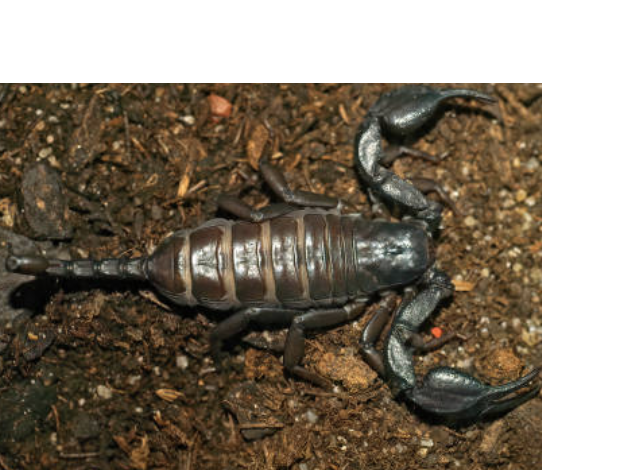
Description: The flat rock scorpion belongs to the class Arachnida and is a species of African scorpions. These scorpions have flattened heads, bodies, and claws. The tail of this scorpion is slender in shape with a small stinger at the end of the tail. Male and female flat rock scorpions are sexually dimorphic; males have longer tails than females, but females have a larger body. They have large claws which help them to hold onto prey easily, even through cracks and small spaces. The color can vary: Red, black, brown, blue, green, and gray.
Native Range: Regions of southern Africa in rocky areas, grasslands, and bushlands.
Lifespan: Up to 25 years in their natural habitat. 30 years or more in human care.
Size: 6-8 inches long
Diet: Small insects like crickets, worms, and mollusks.
Reproduction: Males engage by bragging the pincers of the females and perform a body shaking action to impress them. Females will raise the young alone.
Conservation Status: Not listed by the IUCN.
Interesting Facts: In order to communicate with each other, they use vibrations and pheromones.
They have a very mild venom that generally does not harm humans.
They only need to eat 2-3 times per week.
They do not have very good eyesight and instead use the sensitive hairs on their legs to detect the distance and direction of their prey.
African Spiny Mouse (Acomys spp.)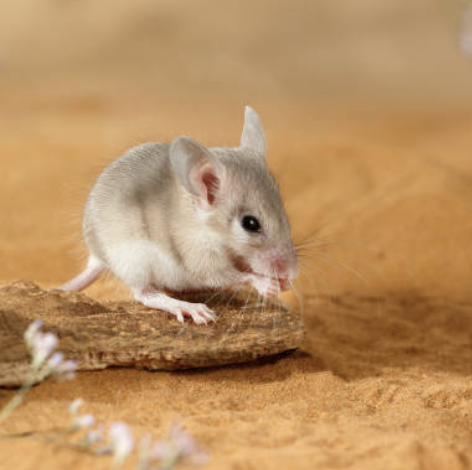
Description: Approximately 18 species of small to medium sized rodents characterized by the harsh, inflexible spiny hairs of the dorsal side of their bodies. African spiny mice have large eyes and ears and scaly, nearly bald tails that are shorter than or about as long as the body. Depending on the species, fur covering the dorsal side of the body may be gray, grayish yellow, brownish red, or red. Black (melanistic) individuals occur in some populations.
Native Range: Range through the northern, eastern, and southern regions of Africa, eastward through southwestern Asia and southern Pakistan to the Indus River. They are also found in southern Turkey and on the islands of Cyprus and Crete. They live in rocky, partially vegetated deserts, savannas, and dry woodlands. They den in rock crevices, termite mounds, or the burrows of other rodents.
Lifespan: 2-4 years in their natural habitat, 4-7 years in human care.
Size: 9-13 cm long, males tend to be slightly longer than females.
Diet: Omnivorous and are known to ingest insects, snails, and seeds and other plant material.
Reproduction: Gestation length is between 28 and 42 days. Litters normally consist of 2 to 3 pups, but females may have up to 6 pups in a single litter. Other females within the social group may assist with the birthing process and tend to the newborns. Pups are born with their eyes open; they will begin to leave the nesting area at about 3 days of age. Babies are weaned around 5 to 6 weeks and reach sexual maturity at 6 to 9 weeks of age. A female can conceive throughout the year and may produce up to 9 litters in a year. Females are able to become pregnant again right after birth.
Conservation Status: Dependent on species.
Interesting Facts: In Egypt, some Cairo Spiny Mice eat mostly dates, but others have been reported to consume the dried flesh and bone marrow of mummies in the tombs of Gebel Drunka.
Two species have been shown to completely regenerate damaged tissue and skin, including hair follicles, sweat glands, and cartilage. No other mammal is known to do this.
Their tails are very delicate and they should never be picked up or handled by their tail.
Socotra Island Blue Baboon Tarantula (Monocentropus balfouri)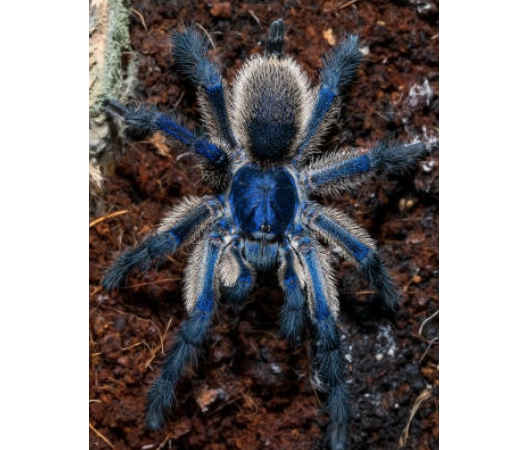

Description: Monocentropus balfouri is also known as the Socotra Island Blue Baboon. Adults and juveniles display striking silver and blue coloring. They create elaborate tube webs. Spiderlings are slow to obtain their adult colors, typically a year or more. They are classified as "mildly venomous" and no deaths have been recorded from a bite from this species. They must be treated with caution and should not be handled with bare hands.
Native Range: The island of Socotra; a unique an isolated island approximately 150 miles east of the horn of Africa, off the coast of Yemen in the Indian Ocean. This area has a tropical to semi-desert climate with fairly moderate temperatures and rainfall.
Lifespan: Males 4+ years, females 10-15 years
Size: Females can reach a legspan of 6-7", males measure slightly smaller.
Diet: Insectivores
Reproduction: Females reach maturity around 2 years of age. Males mature earlier, sometimes as early as 7 months of age. Females care for and defend their offspring until they reach their second molt. Prior to this, young are unable to live on their own. Females can lay up to 2 egg sacs after mating. There is a varying number of individuals hatched per egg sac.
Conservation Status: Not listed by the IUCN Red List. Data deficient.
Native populations are threatened by excessive species collection for the pet trade.
Interesting Facts: The most communal tarantula species. They have evolved into living in close quarters in their natural habitat. Most tarantula species prefer to be kept alone.
Sailfin Molly (Poecilia latipinna)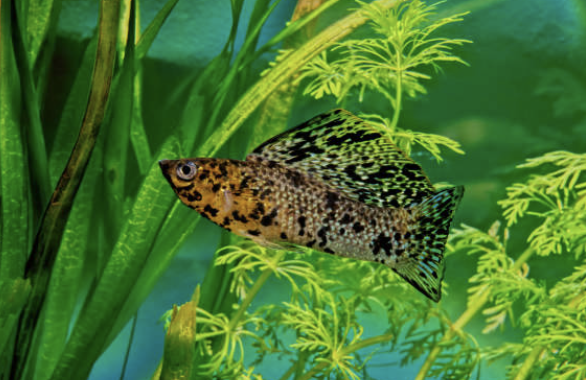
Description: The body of the sailfin molly is oblong. The head is small and dorsally flattened, with a small, upturned mouth. The caudal peduncle is broad and the caudal fin is large, rounded, and sometimes tipped with black. In mature males, the dorsal fin is greatly enlarged and the caudal fin is similarly colorful; these conspicuous secondary sexual characteristics play a role in female mate choice. Females tend to be larger and more plainly colored.
The body is generally light grey, although breeding males may be greenish-blue. Several rows of spots occur along the sides, back, and dorsal fin. Often, these spots blend together to form stripes.
Aquarists have developed many color variations in this species (variation occurs naturally in the wild) with melanistic, leucistic, albino, and speckled forms.
Native Range: They inhabit fresh, brackish, salt, and coastal water from North Carolina to Texas, and the Yucatan Peninsula of Mexico.
Lifespan: Males may live less than a year after achieving sexual maturity. Depending on environmental conditions, they may become reproductive in less than a year.
Size: Males 0.5 to 3 inches, females 0.5 to 2.5 inches
Diet: Algae and other plant material, but will also consume aquatic invertebrates, including the larvae of mosquitoes.
Reproduction: Fertilization is internal, and is accomplished by means of highly modified fin elements within the anal fins of the males that form a structure known as a gonopodium. Broods can have 10-140 live young. Females may store sperm long after the death of their short-lived mates. Gestation for this species is 3 to 4 weeks, depending on temperature. A single female may give birth on multiple occasions throughout the year. No paternal care is exhibited by this species.
Conservation Status: Least concern by the IUCN Red List.
Interesting Facts: Naturally occurring populations control mosquito populations by feeding on the larvae and pupae.
Fennec Fox (Vulpes zerda)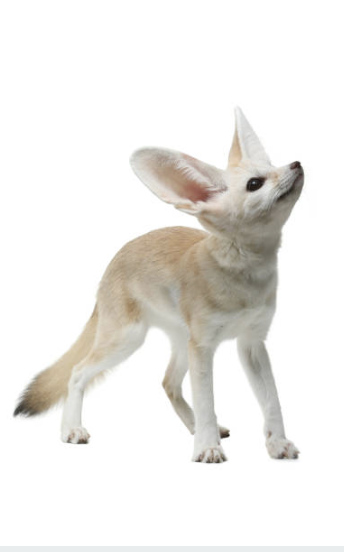
Lifespan: ~10-12 years in human care, reaching sexual maturity at 6-10 months. Fennec foxes can have 2 litters/ year if there is an unsuccessful first litter. Usually, a litter will consist of 2-5 pups.
Size: While having the biggest ears of canids, they are also the smallest canid species. They weigh 2.2-3.3 lbs. and range in size from 9.5-16 inches head to body. In addition, their tails range from 7-12.2 inches long. Their ears alone are about 4-6 inches long. Males are larger than females.
Diet: fennec foxes are mainly carnivorous but will occasionally eat available vegetation such as fruit or berries since they are opportunistic. Their carnivorous diet includes small organisms such as insects, eggs, birds, lizards, small rodents, and even snails.
Adaptations:
- Coats can range from reddish cream to almost white. Their undersides are a stark white with their tails ending in a black tip. Their fur is soft and thick, with their tails being bushy.
- This color fur allows them to camouflage in their native habitat, desert sand.
- Their paws have thick fur that covers, allowing them protection from the hot sand, as well as provide traction while running.
- Their ears are their most distinctive quality. They are the largest ears relative to body size of all the canid family. This aids them in a couple ways:
- Being so large, with lots of surface area and capillaries running through, it assists them in keeping cool in the desert heat (think elephants).
- These large ears assist greatly with hunting small prey underneath the sand at night.
- Fennec Foxes have large round eyes that assist them with seeing better in the nighttime. This is a common trait among nocturnal animals.
- Living in the desert, fennec foxes have adapted to gaining most of their hydration from food therefore are able to go long stretches without water. Their kidneys have special functions that allow this adaptation.
Natural History:
- True foxes (12 species) evolved in North America with many other canids.
- ~8 Million years ago fox crossed the Bering Strait into Asia and spread throughout into what we see as Europe and Africa
- The Fennec fox had a microevolution which are anatomical changes within a species
- Allen’s rule of evolution that animals evolve based on climate with their extremities adapting to the environment
- Bergmann’s rule which states that animals in colder climates tend to be bigger and those in hotter climates to be smaller.
Behavior:
- These animals are nocturnal, doing all of their hunting and energy expending efforts during the cool desert nights. This way of life also keeps them safe as many of their predators are diurnal. Because of this, you may notice that they are sleeping most of the day. This is a good time to talk to guests about their adaptations as they will be laying still to point out their awesome features.
- In their natural habitat Fennec Foxes often live in groups of about 10 individuals.
- They spend their days in their burrows, which can be about 3.5ft deep, to keep safe
- Very agile, Fennec foxes can reach speeds up to 20 mph, jump about 6ft upwards, and 4ft outwards.
- As with most canids, male fennec foxes mark their territory with urine and become a bit more aggressive during their breeding season
- They are monogamous animals and mate for life.
Range: Northern African and Arabian deserts (Sahara and Siani)
Predators: Fennec foxes are tough prey to catch due to their quick nature and their time spent in burrows during the day. Their predators include birds of prey, specifically the eagle-owl, jackals, hyenas, and caracals.
Conservation Status/ Threats: Fennec Foxes are classified as Least Concern and are legally protected in Morocco, Algeria, Egypt, and Tunisia. While their overall populations are stable, they are rarer in parts of North and Northwestern Africa. This is due to habitat loss, hunting, and trapping for exhibition or sale into the pet trade. Fennec foxes are popular exotic pets which poses a threat to their genetic diversity due to poor breeding practices within the pet trade. An educational point for this topic is being sure you are getting pets from reputable sources or rescues and the avoidance of exotic pets due to the nature of which they are brought into the pet trade.
Our Fennec Foxes:
Trooper
- Male
- 1.32 kg
- Born at Palm Beach Zoo at Dreher Park
- Birthdate: 5/25/2013
- Came to TMA from Cincinnati Zoo on 1/31/23
Hokees
- Female
- 1kg
- Born at Smithsonian National Zoo
- Birthdate: 2/4/2016
- Came to TMA from Cincinnati Zoo on 1/31/23
Leopard Tortoise (Stigmochelus pardalis)
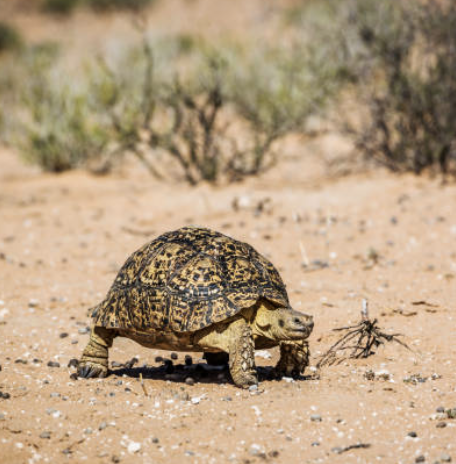
Description: The leopard tortoise is one of the largest tortoises. Has markings on its shell that resemble leopard spots. Domed shell with steep sides. They are slow and quiet, not aggressive. Leopard tortoises generally do not climb or burrow much. Most active at dawn and dusk, when the temperature is moderate.
Native Range: Dry savannahs of southern and eastern Africa. They do not easily tolerate a damp or cold environment.
Lifespan: 80 - 100 years
Size: 12-18 inches long. 30-100 lbs.
Diet: Leopard tortoises are herbivores, feeding on a wide variety of plants, including mixed grasses, succulents and thistles. A hard, sharp beak-like mouth enables them to bite and rip at their food.
Reproduction: Leopard tortoises reach sexual maturity at 12 - 15 years old. While generally docile in captivity, males in the wild can be aggressive with each other during mating season. Nesting occurs between May and October, with the female laying up to seven clutches of 5 - 30 eggs each in a season. Incubation takes between 8 - 15 months dependent on temperature. Hatching tends to happen quicker in warmer temperatures. Eggs and hatchlings can be predated upon by monitor lizards, snakes, jackals and crows.
Conservation Status: Least concern. Leopard tortoises are not considered threatened, but they do face pressure from habitat loss, and they are heavily exploited in the pet trade.
Interesting Fact: Leopard tortoises store water in large anal sacs that take up the majority of the space in their abdominal cavities. This is a key physical adaptation for the arid environment in which they live.
Meerkat (Suricata suricatta)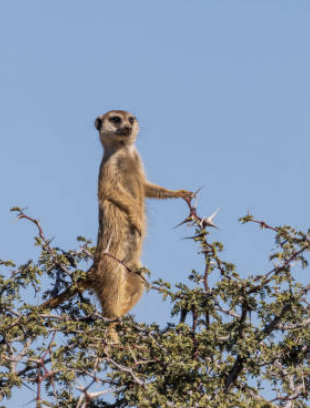
A member of the mongoose family, meerkats (also known as suricates) have grizzled gray and brown colored coats of fur with dark patches around their eyes, which help protect their eyes from the glare of the sun. They also have a dark tip on the tail. Meerkats have powerful foreclaws for digging. Their pointed snout helps enable them to excavate prey from narrow trenches.
Size: Meerkat's slender bodies are 10-14 inches long and their tails are almost as long as their bodies at 7-10 inches.
Natural Range: They live in Southern Africa, including South Africa, Botswana, Zimbabwe and Mozambique. They live in dry, open plains, savannas, and grasslands.
Communication: Meerkats are gregarious and have at least ten distinctive vocalizations. Females tend to be more vocal than males. Vocalizations include murmurs, threatening growls and spits, scolding clucks, and defensive alarm bark.
Diet: Meerkats primarily eat insects, such as grubs and termites, but will also eat small vertebrates, eggs, and some plant matter. They may chew on tsama melons and dig up roots for water. They are very possessive of their food and defend their prey from other members of their pack. Our meerkats eat commercial carnivore mix, feline diet, apples, root vegetables, mealworms, crickets, and earthworms.
Social Structure: Active and social animals, meerkats live in groups that can include as many as 30 individuals, although the average pack size is around 10-15 individuals. Groups are called mobs, and each mob may consist of up to three familes living togehter. Each family group consists of a breeding pair and their offspring. The family groups within a single mob tend to get along well together and there doesn't appear to be a linear hierarchy within the mob; however, females seem to be the dominant members of the mob. When a females reaches sexual maturity, she is usually banished from the family. The mob will band together in a large, missing mass to intimidate predators and other mobs.
Reproduction and Development: In their natural habitat, breeding generally takes place during the warm, rainy season (August - March) when food is most abundant, and may occur throughout the year. Males will fight with the females to initiate mating. The gestation period for meerkats is 11 weeks. they have two to five offspring in a litter. After three weeks, the young will leave the burrow for the first time. They are weaned at six to nine weeks. by eight weeks of age the young meerkats look like adults. They reach sexual maturity at about 1 year of age. Fathers help guard the young and non-breeding individuals in the pack also help care for the young.
Lifespan: Meerkats live for about 10-15 years in human care.
Our Meerkats: We currently have 5 meerkats (3 males and 2 females), they are siblings and were born July 2009 at the Hogle Zoo in Salt Lake City.
Watch a video our husbandry staff doing some station training with our meerkats.